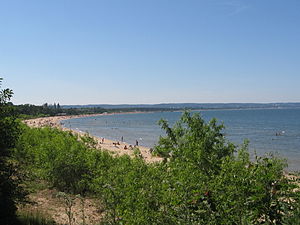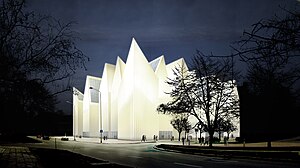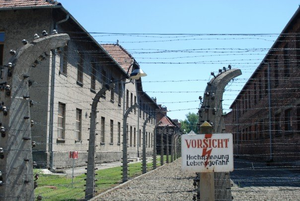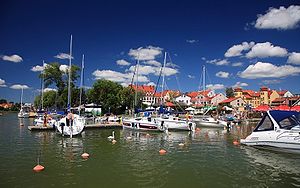This is an old revision of this page, as edited by 82.24.158.189 (talk) at 20:19, 22 April 2017 (→Historic buildings and places). The present address (URL) is a permanent link to this revision, which may differ significantly from the current revision.
Revision as of 20:19, 22 April 2017 by 82.24.158.189 (talk) (→Historic buildings and places)(diff) ← Previous revision | Latest revision (diff) | Newer revision → (diff)| Tourism in Poland | |
|---|---|
| Poland's top ten urban destinations | |
 Kraków, Royal palace at Wawel on the Vistula river, UNESCO World Heritage Site Kraków, Royal palace at Wawel on the Vistula river, UNESCO World Heritage Site | |
 Warsaw, Old Town Market Square, UNESCO World Heritage Site Warsaw, Old Town Market Square, UNESCO World Heritage Site | |
 Wrocław, The Old Town Hall in the Market Square Wrocław, The Old Town Hall in the Market Square | |
 Gdańsk, Baltic beaches of the Gdańsk Bay Gdańsk, Baltic beaches of the Gdańsk Bay | |
 Poznań, International Fair (since 1921) with exhibitors from 70 industrialized countries Poznań, International Fair (since 1921) with exhibitors from 70 industrialized countries | |
 Zakopane, "the winter capital of Poland", view from Gubałówka in the Tatra Mountains Zakopane, "the winter capital of Poland", view from Gubałówka in the Tatra Mountains | |
 Szczecin, New Philharmonic Hall Szczecin, New Philharmonic Hall | |
 Wrocław Zoo Wrocław Zoo | |
 Bydgoszcz, red-brick Lloyd Palace and marina on the Brda Bydgoszcz, red-brick Lloyd Palace and marina on the Brda | |
 Kołobrzeg, historic lighthouse restored to its former glory Kołobrzeg, historic lighthouse restored to its former glory |
Poland is a part of the global tourism market with constantly increasing number of visitors. Tourism in Poland contributes to the country's overall economy. The most popular cities are Kraków, Wrocław, Gdańsk, Warsaw, Poznań, Lublin, Toruń and the historic site of Auschwitz - German nazi concentration camp in Oświęcim. The best recreational destinations include Poland's Masurian Lake District, Baltic Sea coast, Tatra Mountains (the highest mountain range of Carpathians), Sudetes and Białowieża Forest. Poland's main tourist offers consist of sightseeing within cities and out-of-town historical monuments, business trips, qualified tourism, agrotourism, mountain hiking (trekking) and climbing among others. Poland is the 17th most visited country in the world by foreign tourists, as ranked by World Tourism Organization (UNWTO) in 2012.
| Arrivals of foreign tourists by country of origin in 2014 * | ||||
|---|---|---|---|---|
| 1. Germany | 1,385,922 | |||
| 2. United Kingdom | 367,346 | |||
| 3. Russia | 345,760 | |||
| 4. Ukraine | 274,476 | |||
| 5. USA | 235,705 | |||
| 6. Belarus | 225,503 | |||
| 7. Italy | 222,090 | |||
| 8. France | 208,810 | |||
| 9. Norway | 179,305 | |||
| 10. Spain | 176,094 | |||
| 11. Israel | 164,470 | |||
| 12. Sweden | 143,750 | |||
| 13. Netherlands | 128,888 | |||
| 14. Lithuania | 121,091 | |||
| 15. Czech Republic | 99,858 | |||
| * Foreign tourists in tourist accommodation establishments by country | ||||
Overview
Other Poland's top rating destinations Auschwitz concentration camp, UNESCO World Heritage Site
Auschwitz concentration camp, UNESCO World Heritage Site European bison at Białowieża Forest, a UNESCO World Heritage Site and Biosphere Reserve
European bison at Białowieża Forest, a UNESCO World Heritage Site and Biosphere Reserve Wieliczka Salt Mine, with 1.2 million visitors annually
Wieliczka Salt Mine, with 1.2 million visitors annually Medieval Malbork Castle in Malbork, northern Poland
Medieval Malbork Castle in Malbork, northern Poland Masurian Lake District, with more than 2,000 lakes. Pictured: marina in Mikołajki resort town
See also: List of World Heritage Sites of Poland and List of Historic Monuments (Poland)
Masurian Lake District, with more than 2,000 lakes. Pictured: marina in Mikołajki resort town
See also: List of World Heritage Sites of Poland and List of Historic Monuments (Poland)
Poland, especially after joining the European Union in 2004, became a place frequently visited by tourists. Most tourist attractions in Poland are connected with natural environment, historic sites and cultural events. They draw millions of tourists every year from all around the world. According to Tourist Institute's data, Poland was visited by 15.7 million tourists in 2006, and by 15 million tourists in 2007, out of the total number of 66.2 million foreign visitors. In 2012, Poland was visited by 13.5 million foreign tourists (those who came during Euro 2012, but did not stay overnight, were not included in official statistics). In year 2013 Poland was visited by 15.8 million tourists.
Natural environment
See also: List of national parks of PolandPoland has a diversified natural environment, which is relatively unaffected by human development. Visitors are attracted by mountains, sea-coast, forests and the lake reserves. Among the most popular destinations are: Tatra Mountains, in which is the highest peak of Polish (Rysy) and the famous Orla Perć; Karkonosze, Table Mountains, Białowieża Forest, Lower Silesian Wilderness, Bieszczady, Dunajec River Gorge in Pieniny, Pojezierze Mazurskie, Kampinos National Park and many others.
The first Polish tourists were pilgrims traveling to shrines both within Poland and abroad. The development of commercial tourism began in the 19th century. The most popular regions were mountains, especially the Tatra Mountains, explored for example by Tytus Chałubiński. In 1873 the Polish Tatra Society and in 1909 the Polish Sightseeing Society were established to organize and develop tourism. The 19th century was also the time of the rapid appearance of spa resorts, mostly in Sudetes, Beskids and along the Baltic Sea coast, with some of them associated, since 1910, with the Polish Balneology Association. After Poland regained independence in 1918, Polish tourism boomed, and was encouraged by the government. The first professional Polish tour operator, Orbis, was founded in Lwów in 1923, followed in 1937 by Gromada tourist organization and tour operator.
History
After World War II all tourist organizations were nationalized by the new communist government. The Polish Tatra Society and Polish Sightseeing Society were combined into Polish Tourism-Sightseeing Society (PTTK) and most of the tourist infrastructure was handed over to the newly created Workers Vacations Fund (FWP). Tourism was limited to the Comecon countries. This was the era of governmentally-founded tourism, characterised by mass but low-standard tourism. A typical sight was a holiday campground with small bungalows managed by one of the state-owned companies. Holidays for children and teenagers were organized by Juventur. After the fall of communism much of the infrastructure was privatized, although many company-owned resorts were downgraded because of their unprofitability. The early 1990s saw the foundation of many new tour operators. Some of them prevailed and strengthened their position on the market, being able to compete with multinational tour operators like TUI, or Neckermann und Reisen with branches in Poland.
Tourist destinations
- The Royal Road of Kraków
- Tourist attractions in Warsaw
- Wrocław Zoo (ticket most frequently visited attraction in Poland)
- Gdańsk Old Town in Gdańsk
- The Royal-Imperial Route in Poznań
- Jewish Heritage Trail in Bialystok
- European Route of Brick Gothic
- Białowieża National Park
Historic buildings and places
- Kraków Old Town
- Wrocław including Ostrów Tumski, Market Square and the Centennial Hall, Wrocław Cathedral
- Auschwitz-Birkenau State Museum
- Krasiński Palace
- 13th century Wieliczka Salt Mine
- Medieval Town of Toruń
- UNESCO Old City of Zamość
- Wilanów Palace
- Jasna Góra Monastery in Częstochowa
- Cistercian Lubiąż Abbey
- Cistercian Krzeszów (Grüssau) Abbey
- Royal Gniezno Cathedral
- Wooden Churches of Southern Little Poland
- Wooden Churches of Peace in Jawor and Świdnica
- Sanctuary in Kalwaria Zebrzydowska
- Poznań Old Town and its Ostrów Tumski, Poznań
- St. Mary's Basilica in Kraków
- Mount Ślęża in the Sudetes
- Saints Peter and Paul Church in Kraków
- Kłodzko Fortress complex
- Sukiennice Cloth Hall
- Underground Project Riese
- Augustów Canal with sluices
- Muskau Park shared with Germany
- Palace on the Isle
- Poznań Town Hall
- Historic Town of Płock
- Frombork Cathedral
- St. Mary's Church in Gdańsk
- Łańcut Palace
- Kozłówka Palace
- Historic town of Sandomierz
- Kazimierz Dolny
- Poznań Cathedral
- Wrocław Town Hall
- National Museum in Warsaw
- Seaside resort of Sopot
- Branicki Palace
- Historic town of Kłodzko
- Kurozwęki Palace
- Nieborów Palace
- Palace of the Kraków Bishops in Kielce
- Historic town of Wadowice
- Czartoryski Museum
- National Museum in Wrocław
- National Museum in Poznań
- Święta Lipka Basilica
- Historical town of Przemyśl
- Seaside resort of Kołobrzeg
Castles
See also: List of castles in Poland Main article: Trail of the Eagles' Nests- Wawel Royal Castle
- Royal Castle in Warsaw
- Niedzica Castle
- Malbork Castle
- Baranów Sandomierski Castle
- Książ Castle
- Nowy Wiśnicz Castle
- Czocha Castle
- Moszna Castle
- Ujazdowski Castle
- Imperial Castle in Poznań
- Grodziec castle
- Krasiczyn Castle
- Pieskowa Skała
- Lidzbark Warmiński Castle
- Kwidzyn Castle
- Kliczków Castle
- Golub-Dobrzyń Castle
- Krzyżtopór
- Ogrodzieniec Castle
- Dunajec river castles
- Chojnik Castle
- Bobolice Castle
- Będzin Castle
- Pomeranian Dukes' Castle, Szczecin
- Tenczyn Castle
- Bolków Castle
- Czersk Castle
- Ciechanów Castle
- Lublin Castle
- Uniejów Castle
- Darłowo Castle
- Bielsko-Biała Museum and Castle
Cultural events
Further information: Culture of Poland- Warsaw
- Kraków
- Jewish Culture Festival in Kraków
- Floating of the Wreaths (Wianki)
- Kraków szopka nativity crèche festival
- International Film Festival Etiuda&Anima
- International Festival of Independent Cinema Off Plus Camera
- Wrocław
- Poznań
- Tricity
- Other
Tourist resorts
There are dozens of sea resorts on the coast of Baltic Sea like Wolin Island, located close to the German border and the coast of Pomerania. In southern Poland there are resorts for skiing and hiking in the Karkonosze mountains, which is part of the Sudetes mountain range. Karkonosze includes the touristical centres of Karpacz and Szklarska Poręba. Other famous resorts for skiing and hiking include in Carpathian Mountains: Zakopane in the Tatra mountains; Szczyrk, Krynica-Zdrój, Ustroń, Wisła in Beskides or Szczawnica and Krościenko in Pieniny mountains.
Holocaust and Shtetl tourism
Main articles: Holocaust tourism and POLIN Museum of the History of Polish Jews- Shtetl Routes - shtetl routes of the Polish, Belorussian and Ukrainian borderland
Christian pilgrimage
Main article: Christian pilgrimageIt's estimated that 13% (of the 1.8 million in 2005) of visitors of the Basilica of Our Lady of Licheń arrive from abroad. Jasna Góra Monastery was visited by 3.6 million of pilgrims from 78 countries in 2014.
Transport in Poland
Main article: Transport in Poland
Since the fall of communism transport in Poland has improved significantly. There is acceptable tourist infrastructure, especially in larger cities and in major tourist resorts. Most major Polish cities (e.g. Kraków, Wrocław, Poznań, Gdańsk and Szczecin) have international airports with connecting services with the Frédéric Chopin International Airport in Warsaw. Intercity travel supports the PKP Intercity, Przewozy Regionalne, local trains (Koleje Dolnośląskie, Koleje Śląskie, Koleje Małopolskie, Arriva RP, Szybka Kolej Miejska (Tricity), Pomorska Kolej Metropolitalna, Koleje Mazowieckie, Łódzka Kolej Aglomeracyjna, Koleje Wielkopolskie, ) and PKS's, PolskiBus and many smaller companies. There are also coach connections to other countries provided by various companies (inter alia Eurolines). Connections by ferry to Sweden and Denmark through the Baltic Sea are for example from Gdańsk, Gdynia and Świnoujście (inter alia Polferries).
See also
- Polish Tourist and Sightseeing Society (Template:Lang-pl)
- Mountain Volunteer Search and Rescue (Template:Lang-pl)
- Tatra Volunteer Search and Rescue (Template:Lang-pl)
- Crown of Polish Mountains
- List of spa towns in Poland
References
- ^ TripAdvisor. "Top 10 Destinations – Poland". Travelers' Choice 2013 (Winners). TripAdvisor.ca The world largest travel site. pp. 1 of 10. Retrieved 20 December 2014.
Travelers' Choice 2014 Update: 1.Krakow, 2.Warsaw, 3.Wroclaw, 4.Poznan, 5.Bialystok, 6.Sopot, 7.Zakopane, 8.Lodz, 9.Szczecin, 10.Gdynia.
{{cite web}}: External link in|quote= - UNWTO Tourism Highlights "International Tourist Arrivals by County of Destination (Poland)". UNWTO World Tourism Barometer. World Tourism Organization. 2013. Retrieved 27 October 2013.
{{cite web}}: Check|url=value (help) - ^ Overnight stays in accommodation establishments in 2014 (PDF file, direct download 8.75 MB), Główny Urząd Statystyczny (Central Statistical Office (Poland)), pp. 174–177 / 254. Warsaw 2015.
- ^ The Touropia Team (2013). "10 Top Tourist Attractions in Poland". Touropia “best of” lists. Touropia. Retrieved 26 November 2013.
- ^ Touristrack. "10 Famous Tourist Attractions In Poland You Must Visit". Central Europe. TourisTrack.com. Retrieved 26 November 2013.
- Information about tourism in Poland (in Polish). Source: Instytut Turystyki, 2008.
- GUS (2008). "Przyjazdy do Polski (Foreign visits to Poland)". Statistics (in Polish). Instytut Turystyki. Retrieved December 31, 2012.
- Katarzyna Sobierajska, Ministry of Tourism (2012). "Pierwsze efekty Euro 2012. Resort turystyki przewiduje wzrost liczby turystów w 2013 r. nawet o pół miliona". Live interview (in Polish). Agencja Informacyjna Newseria. Retrieved December 31, 2012.
{{cite web}}: Italic or bold markup not allowed in:|publisher=(help) - Zoo Wrocław – lepsze od Wawelu i Wieliczki
- Narodowy Instytut Dziedzictwa, "Wrocław – zespół historycznego centrum." Template:Pl icon
- Poland national tourism office
- Useful information site about Poland
- Poland's Official Travel Website
- Visiting Poland - All in One Travel Guide
Further reading
- Kaszynski, Tadeusz, Through Europe to Poland by Car, 1st and rev. ed., New York, 1968
| Poland articles | |||||||||
|---|---|---|---|---|---|---|---|---|---|
| History |
| ||||||||
| Geography | |||||||||
| Politics | |||||||||
| Economy | |||||||||
| Society |
| ||||||||
| Tourism in Europe | |
|---|---|
| Sovereign states |
|
| States with limited recognition | |
| Dependencies and other entities | |